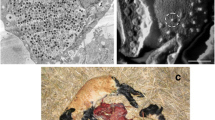Abstract
Rapid and precise diagnosis in natural field cases of bovine abortion caused by Campylobacter fetus subsp. venerealis warrants use of most sensitive and reliable diagnostic methods. In the present study, an array of gross, histopathological, immunohistochemical and real time polymerase chain reaction (PCR) technique(s) for amplification of the gene encoding ISCfe1 insertion site were applied for the diagnosis of C. fetus subsp. venerealis in cases of abortion. Abortion occurred between 4 and 6 months of gestation with an average gestational age of 5 months. Histopathologically, fetal lesions recorded were bronchopneumonia and interstitial pneumonia. C. fetus with the typical morphology of spirals was observed in sections of lung with IHC staining positive reaction. In placenta, there was dense staining of clusters of the organisms which were evident as dark brown bodies showing positive reaction with IHC. Four samples (two from stomach contents, one from pooled fetal tissue and one from vaginal discharges) out of 84 tested cases were positive by real-time PCR for diagnosis of C. fetus subsp. venerealis in cases of abortion. Real time PCR techniques using ISCfe1 insertion site is most sensitive technique for diagnosis of C. fetus subsp. venerealis associated abortion.







Similar content being viewed by others
References
Eaglesome M, Garcia M (1992) Microbial agents associated with bovine genital tract infections and semen. Part I. Brucella abortus, Leptospira, Campylobacter fetus and Tritrichomonas foetus. Vet Bull 62:743–745
Campero CM, Anderson ML, Walker RL, Blanchard PC, Barbano L, Chiu P et al (2005) Immunohistochemical identification of Campylobacter fetus in natural cases of bovine and ovine abortions. J Vet Med 52:138–141
Schmidt T, Venter EH, Picard JA (2010) Evaluation of PCR assays for the detection of Campylobacter fetus in bovine preputial scrapings and the identification of subspecies in South African field isolates. J S Afr Vet Assoc 81:87–92
OIE (2008) Bovine genital campylobacteriosis. Chapter 2.4.5: 661–670
Abril C, Vilei EM, Brodard I, Burnens A, Frey J, Miserez R (2007) Discovery of insertion element ISCfe1: a new tool for Campylobacter fetus subspecies differentiation. Clin Microbiol Inf Dis 13:993–1000
van Bergen MAP, Dingle KE, Maiden MC, Newell DG, van der Graff-van Bloois L, Van Putten JP, Wagenaar JA (2005) Clonal nature of Campylobacter fetus as defined by multilocus sequence typing. J Clin Microbiol 43:5888–5898
van Bergen MAP, Simons G, van der Graff-van Bloois L, van Putten JP, Rombout J, Wesley I, Wagenaar JA (2005) Amplified fragment length polymorphism based identification of genetic markers and novel PCR assay for differentiation of Campylobacter fetus subspecies. J Med Microbiol 54:1217–1224
Lappin MR (2009) Infectious disease diagnostic assays. Top Companion Anim Med 24:199–208
Malorny B, Tassios PT, Rådström P, Cook N, Wagner M, Hoorfar J (2003) Standardization of diagnostic PCR for the detection of food borne pathogens. Int J Food Microbiol 83:39–48
Yang S, Rothman RE (2004) PCR-based diagnostics for infectious diseases: uses, limitations, and future applications in acute-care settings. Lancet Infect Dis 4:337–348
Hum S, Quinn K, Brunner J, On SLW (1997) Evaluation of a PCR assay for identification and differentiation of Campylobacter fetus subspecies. Aust Vet J 75:827–831
Iraola G, Hernandez M, Calleros L, Paolicchi F, Silveyra S, Velilla A, Carretto L, Rodriguez E, Perez R (2012) Application of a multiplex PCR assay for Campylobacter fetus detection and subspecies differentiation in uncultured samples of aborted bovine fetuses. J Vet Sci 13:371–376
Willoughby K, Nettleton PF, Quirie M, Maley MA, Foster G, Toszeghy M, Newell DG (2005) A multiplex polymerase chain reaction to detect and differentiate Campylobacter fetus subspecies fetus and Campylobacter fetus -species venerealis: use on UK isolates of C. fetus and other Campylobacter spp. J Appl Microbiol 99:758–766
Luna LG (1968) Manual of histologic staining methods of the armed forces institute of pathology, 3rd edn. McGraw-Hill, New York
Haines D, Chelack B (1991) Technical considerations for developing enzyme immunohistochemical staining procedures on formalin-fixed paraffin-embedded tissues for diagnostic pathology. J Vet Diagn Invest 3:101–112
Morrell EL, Barbeito CG, Odeo´n CA, Gimeno EJ, Campero CM (2011) Histopathological, immunohistochemical, lectinhistochemical and molecular findings in spontaneous bovine abortions by Campylobacter fetus. Reprod Domest Anim 46:309–315
Tucuz M, Oruc E, Tucuz N, Yoldas A, Yiğin A (2010) Diagnosis of Campylobacteriosis in the aborted bovine fetuses by pathological, immunohistochemical, microbiological and real time PCR. Kafkas Univ Vet Fak Derg 16:509–514
Schulze F, Bagon A, Müller W, Hotzel H (2006) Identification of Campylobacter fetus subspecies by phenotypic differentiation and PCR. J Clin Microbiol 44:2019–2024
McGoldrick A, Chanter J, Gale S, Parr J, Toszeghy M, Line K (2013) Real Time PCR to detect and differentiate Campylobacter fetus subspecies fetus Campylobacter fetus subspecies venerealis. J Microbiol Methods 94:199–204
Wilhelm J, Pingoud A (2003) Real time polymerase chain reaction. ChemBioChem 4:20–28
McMillen L, Fordyce G, Doogan VJ, Lew AE (2006) Comparison of culture and a novel 51 Taq nuclease assay for direct detection of Campylobacter fetus subsp. venerealis in clinical specimens from cattle. J Clin Microbiol 44:938–945
Vargas A, Costa M, Vainstein M, Kreutz L, Neves J (2003) Phenotypic and molecular characterization of bovine Campylobacter fetus strains isolated in Brazil. Vet Microb 93:121–132
Acknowledgments
The authors are very thankful to Dr. Naresh Kumar Sood, Professor, Department of Veterinary Pathology for providing the necessary lab facilities and chemicals.
Author information
Authors and Affiliations
Corresponding author
Rights and permissions
About this article
Cite this article
Mahajan, V., Banga, H.S. & Gupta, A. Immunohistochemical and Molecular Approaches for the Diagnosis of Campylobacter fetus subsp. venerealis in Natural Cases of Bovine Abortion. Proc. Natl. Acad. Sci., India, Sect. B Biol. Sci. 85, 673–677 (2015). https://doi.org/10.1007/s40011-014-0369-9
Received:
Revised:
Accepted:
Published:
Issue Date:
DOI: https://doi.org/10.1007/s40011-014-0369-9




